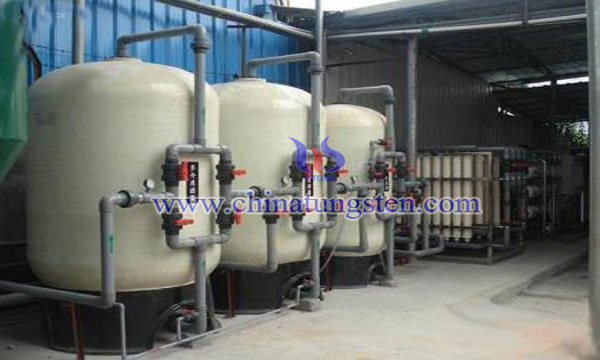Comprehensive Treatment of Tungsten Waste Water after Ion Exchange
- Details
- Category: Tungsten Information
- Published on Monday, 18 June 2018 19:29
In the process of the production of ammonium para Tungstate by ion exchange, there will be a large amount of waste water, including four kinds of waste water, washing water, ammonia washing water, and crystal mother liquor. The wastewater mainly contains tungsten, alkali, chloride ion, ammonia nitrogen, COD, a small amount of arsenic, fluoride ion and other elements. Because of the complex composition of the wastewater, the traditional wastewater treatment methods can not simultaneously achieve multiple components at the same time, so the treatment effect is not good, it also needs to spend a lot of cost to ensure the environmental emission indicators.

A large tungsten enterprise in Jiangxi uses comprehensive recovery method to recycle and reuse the waste water after ion exchange.
1) Deamination of crystallized mother liquor. The wastewater from the crystalline mother liquor is first added to the alkali to adjust the pH to the specified value, and the evaporating reaction deamination cooker is pumped into the evaporating reactor. When the ammonia nitrogen in the wastewater is lower than 300mg/l, the liquid collection trough is mixed with the mixed liquid.
2) Recovery of tungsten from the effluent of the liquid and crystallization mother liquid. The mixed solution of the post intersection liquid and the crystallization mother liquor after deamination is discharged into the pH regulating pool, and the aeration is uniform, adding sulfuric acid, adjusting the pH of the waste water to the specified value, the adjusted wastewater, after the liquid plate and frame filter press, to remove the precipitation in the wastewater, and the clear solution is adsorbed by the D318 macroporous resin back column to adsorb the tungsten in the waste water.
3) Comprehensive treatment of waste water from mother liquor and mother liquor. After the recovery of tungsten, the wastewater is directly discharged into the comprehensive treatment pool to remove arsenic, ammonia nitrogen, COD, fluorine and so on. The process is that after the wastewater is evenly aerated, the required material A is added by sampling and analysis, and then the required material B is added to the required material after the aeration is uniform and the aeration is uniform. After half an hour after the reaction, the required material C was added, the aeration was half an hour after the aeration was uniform, and then the required material D was added, and after the analysis reached the required requirement, the filter was filtered to remove the precipitate residue from the waste water, and the filtrate after filtration was discharged into the mixed pool of waste water.
4) Recovery and treatment of sodium washing water and chlorine washing water. The wastewater of high ammonia nitrogen washing in the early stage of chlorine washing is discharged into the mixed collection pond to carry out the follow-up ammonia nitrogen and COD depth treatment, while the cleaner sodium washing water and the later chlorine washing water are discharged directly into the wastewater collection and precipitation collection pool, and then filter through the plate frame filter press.
5) Deep treatment of ammonia nitrogen and COD. The wastewater in the mixed wastewater collection pool is discharged into the ammonia nitrogen treatment pool. As the treated wastewater mainly contains ammonia nitrogen and COD, the required material E is added through sampling analysis and analysis. The concentration of ammonia nitrogen is lower than 5mg/l under normal operation, and the concentration of COD is lower than that of 60mg/l. If it is exceeding the standard, the required material is properly supplemented.
6) pH fine-tuning and clarification. The treated wastewater is discharged into the pH fine tuning pool. By adding a small amount of liquid alkali or sulfuric acid, the wastewater is adjusted to pH, and the wastewater after the micro adjustment of pH is discharged into the clarifier. After clarification, the effluent from the waste water is reduced and the outer row of the SS is reduced.
This process has a good effect on recovery of tungsten in waste water and high recovery rate. On the basis of the original metal recovery rate, the recovery rate of the metal is increased by 1.5%, the total metal recovery rate is above 98%, and the recovery method is simple and the recovery cost is low. The recovered tungsten solution can be directly returned to the production process and does not produce other pollution.
- Tungsten Manufacturer & Supplier, Chinatungsten Online: www.chinatungsten.com
- Tungsten News & Prices of China Tungsten Industry Association: www.ctia.com.cn
- Molybdenum News & Price: news.molybdenum.com.cn
- Tel.: 86 592 5129696; Fax: 86 592 5129797; Email: sales@chinatungsten.com



 sales@chinatungsten.com
sales@chinatungsten.com